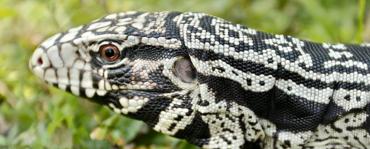
Make room, Burmese pythons ... Tegu lizards are crowding your turf, they're big and scary, and they've been multiplying in South Florida ever since the first one was spotted in 2008 near a Homestead trailer park in the southern part of Miami-Dade County.
Tegus are an invasive species which reproduces quickly and ravenously consumes all kinds of things, including small animals and the eggs of many wildlife species. Tegus are now known to have established significant breeding populations in Miami-Dade, Polk and Hillsborough counties, but plenty have been spotted in Lee, Collier, Palm Beach, and even counties much farther north.
The black-and-white tegu is about 3 feet in length and is native to South America -- specifically Brazil, Paraguay, Uraguay and Argentina. How the first one ended up in South Florida, though, is not entirely clear, although many researchers believe it was either an escaped or freed pet.
They do very nicely, thank you, in much of the Sunshine State, but they are particularly happy in the wet, steamy, food-rich Florida Everglades.
“Their threat potential is serious,” University of Florida biologist Frank Mazzotti told the Florida Keys Free Press. “It’s hard to accurately measure their numbers, but the extent of their population is definitely growing rapidly.”
Mazzotti, along with a team of researchers, has been trapping tegus for the last five years. More recently, he was contracted as part of a South Florida Water Management District and Florida Fish and Wildlife Conservation Commission trap-kill-study program.
The program, in place for the last three years, serves two purposes, Mazzotti said. It helps eradicate the tegus while allowing their behavior to be studied.
Mazzotti told the Florida Keys newspaper the Free Press that these non-natives have been found all the way north to the Florida Panhandle, mainly because of their adaptation to colder climates. Pythons, on the other hand, have not strayed too far from tropical South Florida.
“We do not know their exact boundaries,” Mazzotti said. “So it’s difficult to measure their full impact.”
In fact, tegus have not been outlawed. They are still readily available for purchase in many pet stores and especially from breeders dotted around the Everglades.
An area along a jarring dirt road in the Southern Everglades, not far from the Dade Juvenile Residential Center located off the 18-Mile Stretch, seems to be the prime real estate for the majority of the tegu population, according to researchers.
The lizards spend most of their time on land, though they can swim and may submerge themselves for long periods of time. Tegus can often be seen on roadsides or other disturbed areas. Like many reptiles, they are primarily active during the day and will burrow or hide overnight.
Mazzotti said. “I’d hate to be a Key Largo woodrat or a Lower Keys marsh rabbit.”
Tegus have also been caught feasting on alligator eggs on multiple occasions, he said. Another potential victim, considering around 30 to 40 percent of the invasive species' diet is made up of small animals, is the endangered Cape Sable seaside sparrow.
“The frequency of small animals they prey on is just astonishing,” Mazzotti told the newspaper.
Both pythons and tegus "are very serious threats [to the Everglades ecosystem]. And we’re spending billions of dollars to restore the Everglades,” he said. “Are we just going to let invasive species take it over?”
Reach Nancy Smith at nsmith@sunshinestatenews.com or at 228-282-2423. Twitter: @NancyLBSmith


